Educators implement effective planning, instruction, assessment and reporting practices to create respectful, inclusive environments for student learning and development.
Planning begins with the creation of safe, respectful, and inclusive spaces–ones where all students feel welcomed and free to be themselves.
As educators, we must consider (and value) student diversity within the walls of our classrooms–physically, cognitively, mentally/emotionally, and spiritually.
With this in mind, I created (and present here) my ideal classroom:
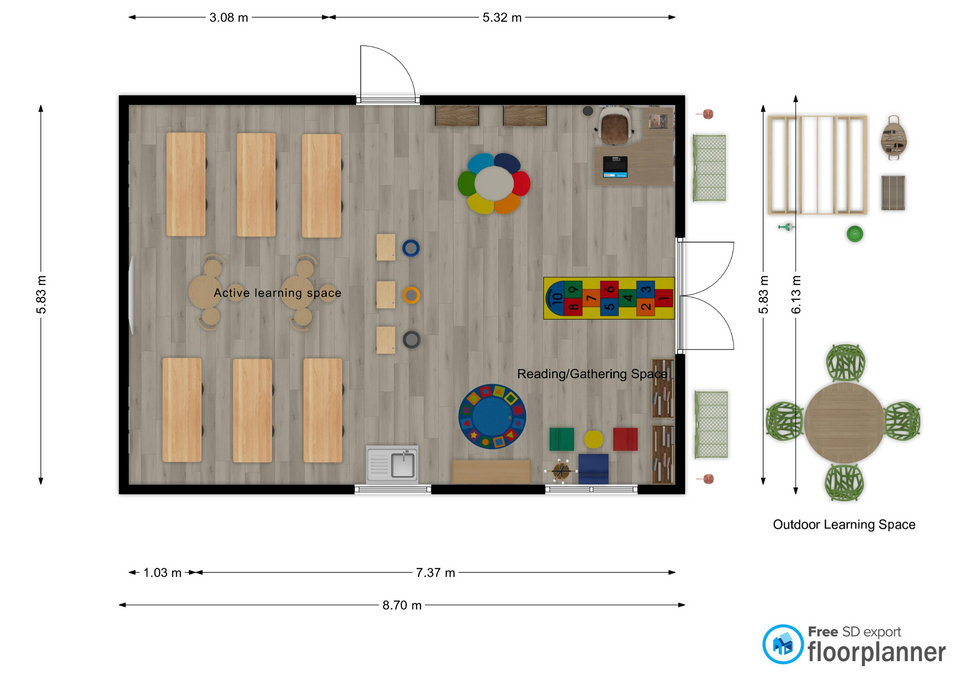
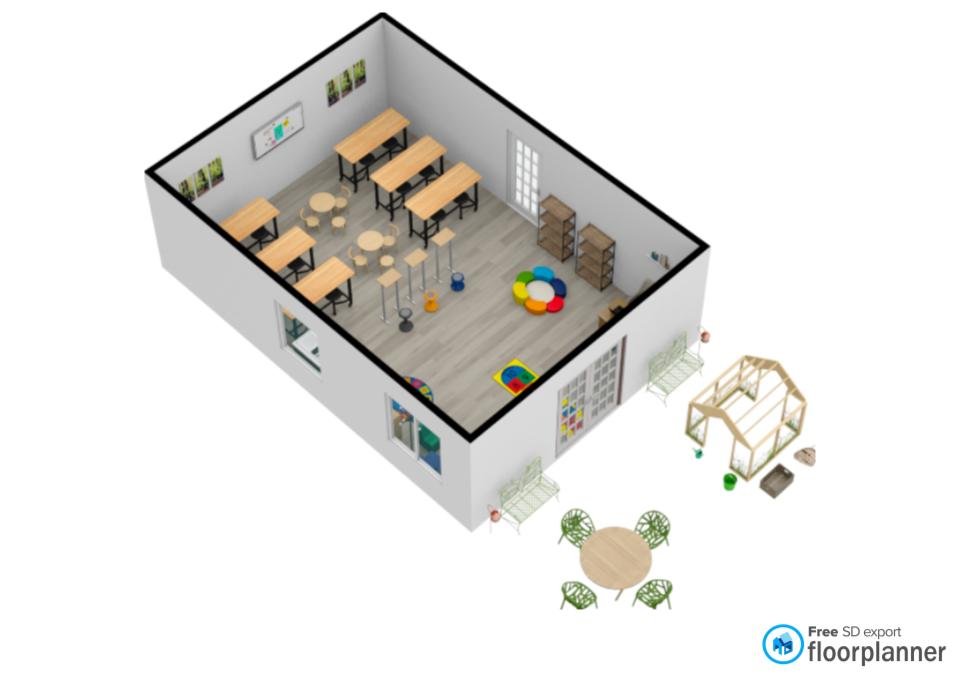
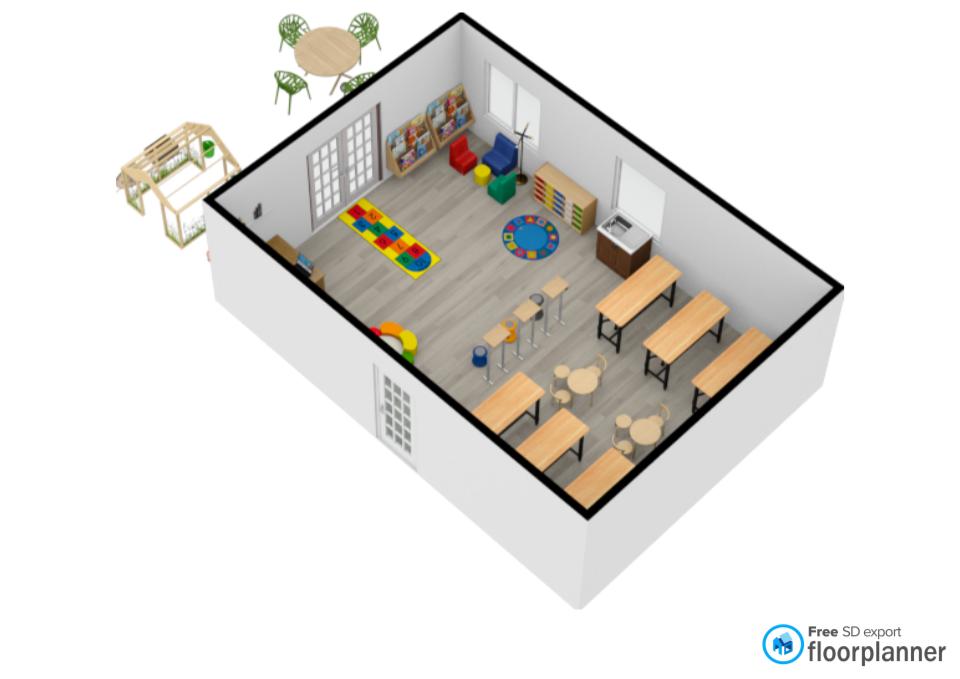
Highlights & Features:
- Large, open space with ample room to move freely and easily, from activity to activity and from learning space to learning space (note that coats and backpacks would be located on hooks in the hallway, outside the single interior door; this limits distractions, frees up square footage and vertical space to be used for informative visuals, interactive learning opportunities, and to showcase student learning).
- Varied spaces:
- Active Learning Space with interactive smartboard and ample flat and vertical spaces for flexible learning opportunities.
- Gathering/Reading Space with comfortable seating, a large carpet, two bookshelves, and a shelving unit with bins of manipulatives and learning resources (ideal space for unwinding/decompressing, reading, storytelling, collaborating, doing floor work, and satisfying connection to people and place).
- Outdoor Learning Space with garden, greenhouse, and ample outdoor seating for students to enjoy fresh air and satisfy the connection to land. Students can get their hands dirty, let their feet touch the grass and soil, grow food and plant seeds; they can learn about sustainability, planting, tilling, and harvesting; about patience, nurturance, and so much more.
- Direct, easy access to outside (Mother Earth) via exterior double-doors.
- Varied seating (high rectangular tables; low, round tables; stand-alone, height-adjustable desks with sit or stand option; wobble seats; flower-petal pull apart sectional; carpet, and sofas/ottomans in the Reading/Gathering Space).
- Ample natural light, via windows that open for fresh air, and double French doors.
- Although the walls and bookcases are shown barren (limited by the technology I was utilizing to design my classroom), imagine that they are vibrant and full of informative visuals and resources to guide students in their learning.
- Teacher’s desk is in the corner, so as not to detract students from working independently or collaboratively with peers, yet fully accessible to students when needed. The spacious area around the teacher’s desk allows students or groups of students to work with the teacher when needed. This is also a neutral, private space where students can consult the teacher as needed.
Within the walls of this space, I aim to provide respectful and inclusive instruction, where student diversity is acknowledged and valued:
Within the walls of this space, I aim to provide student-centred assessment:
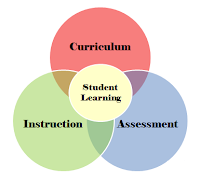
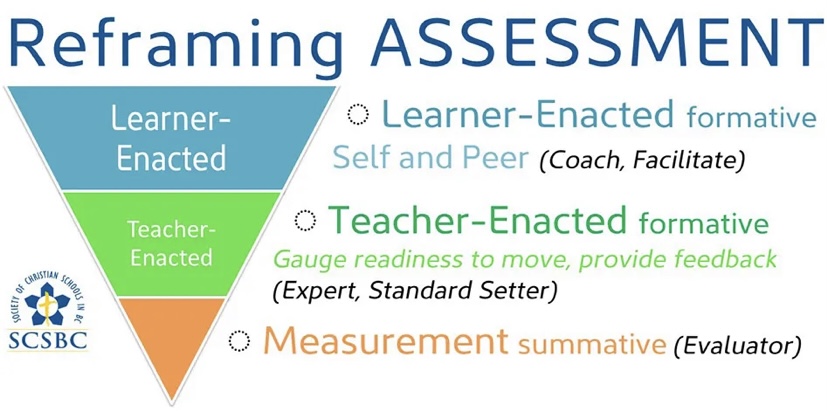
Standard 5 in My Practicums
In designing, facilitating, and adjusting my practicum lessons, I focused on how I could meet the needs of my diverse learners—those who were struggling (my developing and emerging learners), those who were “right on track” (my proficient learners), and those who were already masters (my extending learners). The pressing questions at the back of my mind—before, during, and after lessons—were: (1) how do I ensure that all my student “get it”? and (2) if they do not get it right away, how do I ensure that those not “getting it” receive the time and support they need to “get it” without slowing the pace of instruction to a rate where the proficient and extending learners become bored and disengaged?!? MY CTs and I agreed that the best course of action was to provide as explicit instruction as possible at the outset, approaching the content as though students had never heard of it before. I broke concepts down to their most basic parts and then worked at putting them back together.
I ensured that instruction was engaging to all. I invoked students’ prior knowledge and connected it to new content. I ensured that my lessons were universally designed with all learners in mind and involved oral, visual, and written components. I drew upon technology (using the Smart Board to display visuals and audio-visuals) and gave students choice when it came to how they wanted to work and complete tasks (individually, in pairs, in small groups, or as a class). In most activities—whether during brainstorming and discussion tasks, reading comprehension tasks, written tasks, debate tasks, or math tasks—there was a reasonable level of choice. If a student (or students) struggled, I made sure to take a step back and re-teach and review before moving on. I offered levelled work and students were given “good fit” options that were challenging but not too difficult or frustrating.
I took all cues from my students and adjusted instruction, lessons, and tasks accordingly. I practiced, fostered, and honed my instructional agility—the “iterative process of understanding what you want students to learn, recognizing and interpreting student words and action, and responding in ways that build on students’ strengths, clear up misconceptions, and promote the next steps in their learning” (Erkens et. al., 2017, pg. 110). Although it was a challenge to juggle twenty-seven diverse learners in a single classroom, we (as teachers) must do it every day; those making it look easier than the rest have mastered instructional agility (this is my goal).

During my practicums, my coaching teachers (CTs) commended me on my ability to adjust my lessons and tasks as needed, based on the feedback I received from them and the students directly (in conversations & discussions, in thumbs up/down polls, in exit tickets, in responses to assigned questions and practice problems, and on quizzes) and indirectly (students’ ability to focus on and engage with the instruction and successfully complete assigned tasks). My CTs were equally pleased with my ability to provide students with clear and concise feedback (verbally/formatively and written/summatively) that would guide their learning (taking them from where they were to where they needed to be) and with my ability to track and record evidence of student learning.
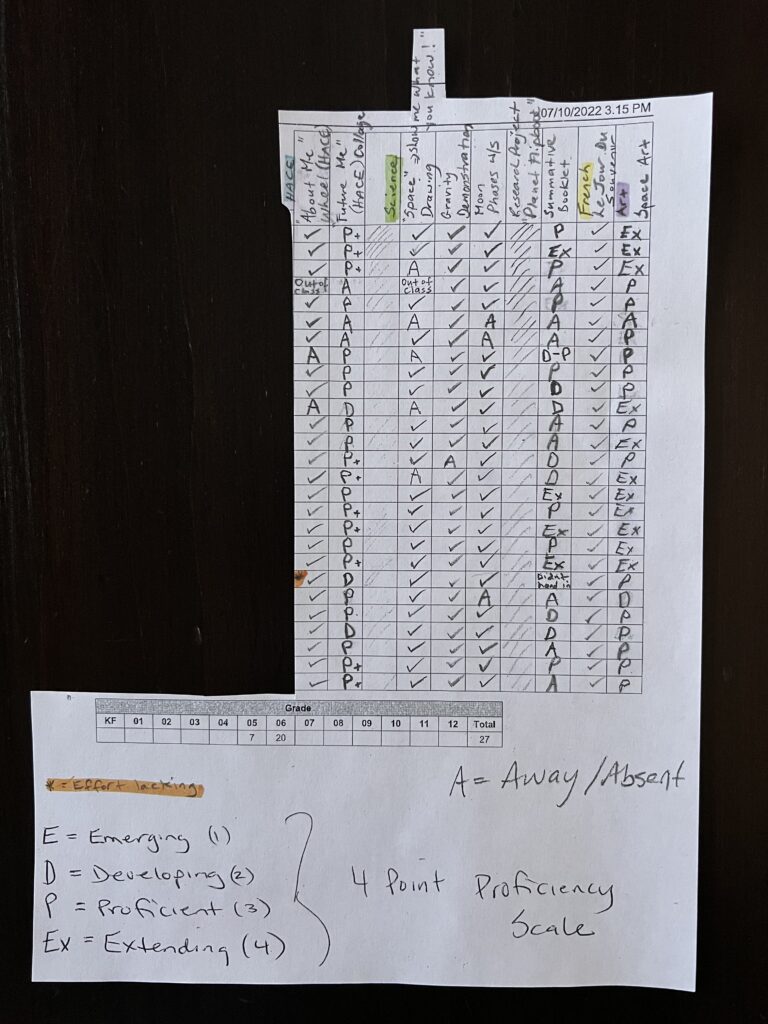
Tracking Evidence of Student Learning in H.A.C.E./Career Education, Science, French, and Art Education
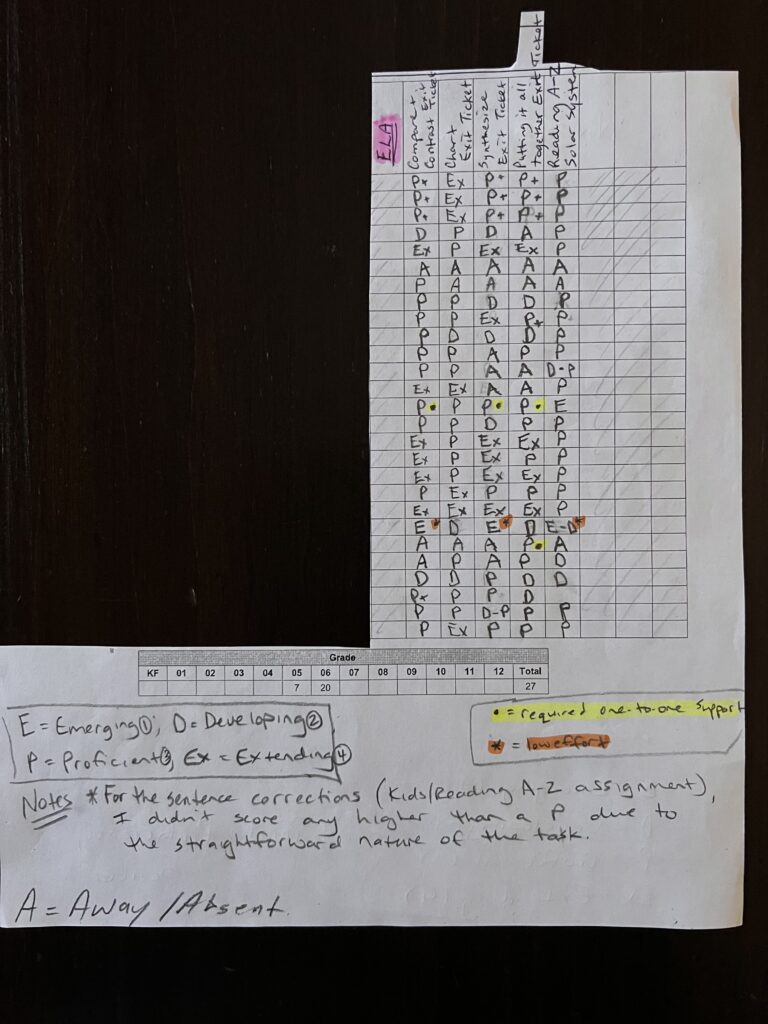
Tracking Evidence of Student Learning in English Language Arts
My assessment efforts in my experiential practicum helped me recognize early on that I needed to offer students levelled math options so that all had “good-fit” problems that were challenging but not too difficult. Students were given the opportunity to reach proficiency and show extending knowledge on low-stake summative quizzes based on what they practiced each week (working toward mastery at different levels). During my second week, I postponed adding a new concept as originally planned, choosing to spend more time working toward mastery before adding another, more challenging step. This decision paid off: students were successful having had the extra time and were ready for the new material when I introduced it at the beginning of my third week.
My planned assessment efforts also enabled me to ensure students understood the criteria and knew what they were being assessed on prior to starting each task. Rubrics were shared during explicit instruction so there were no assessment surprises for anyone involved. I also paid attention to student feedback and showed flexibility when students required longer than expected to complete learning tasks (i.e., reading comprehension questions, group work, debating tasks, etc.). Formative feedback was provided to students verbally during every lesson and in writing on preliminary/practice questions. Summative feedback was provided on summative tasks (i.e., quizzes and end-of-unit tasks).
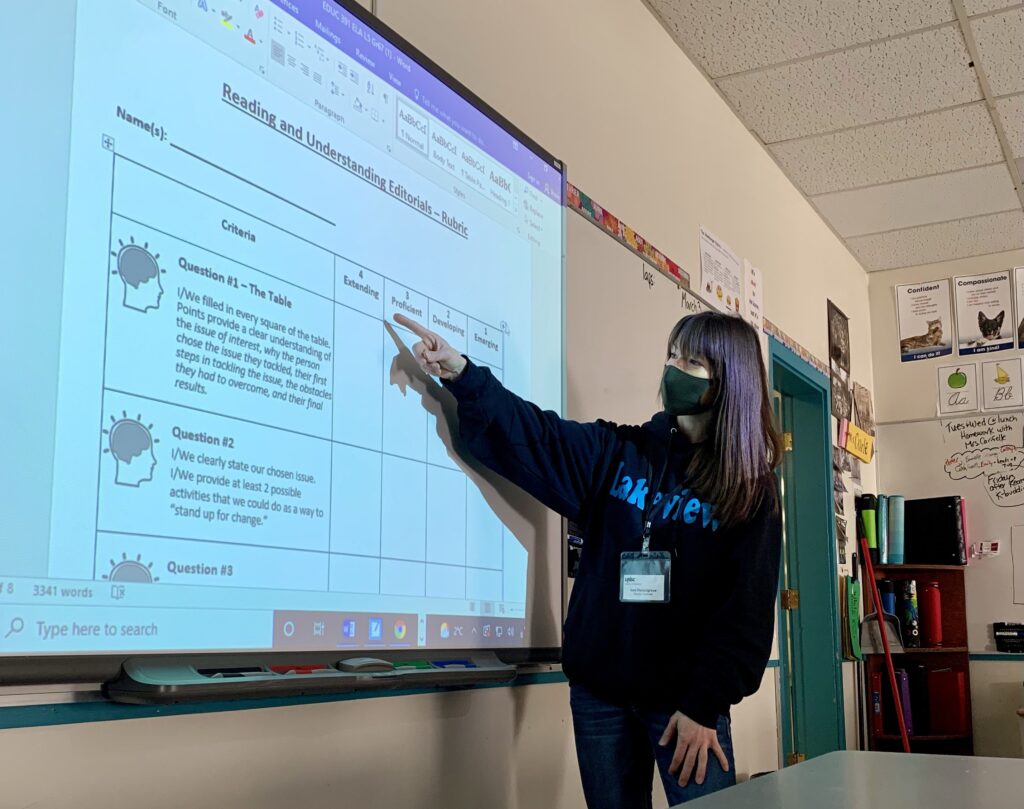

Upon reflection, I am proud of the instruction I provided and of the assessment and motivation strategies I utilized in my practicums.
